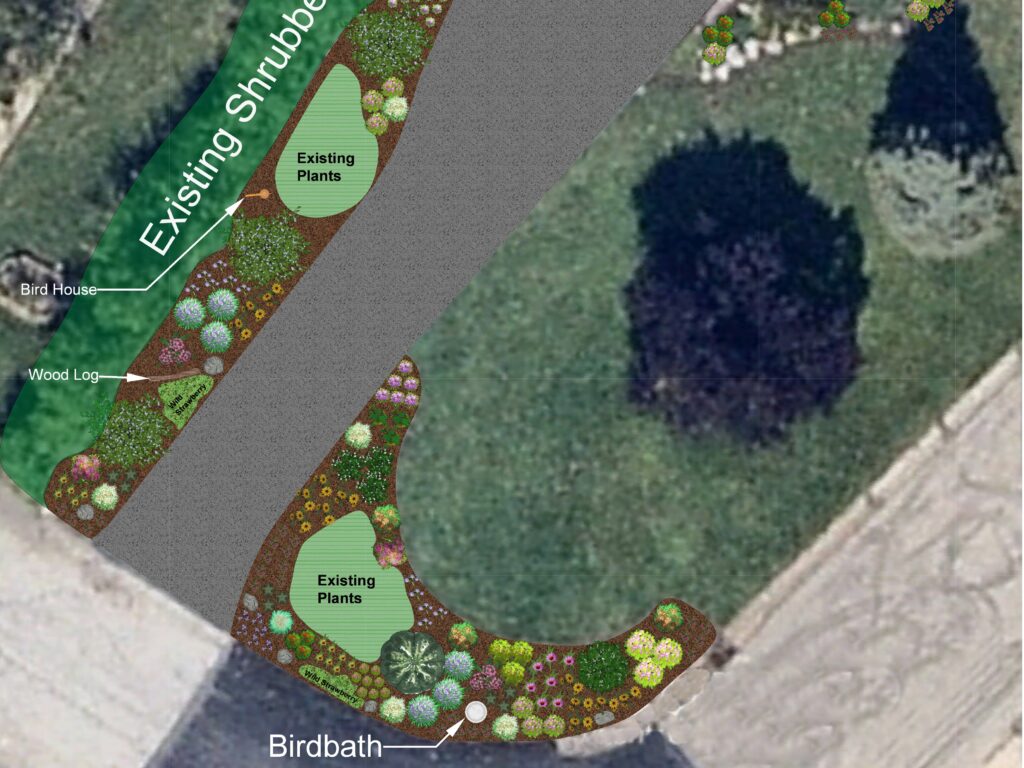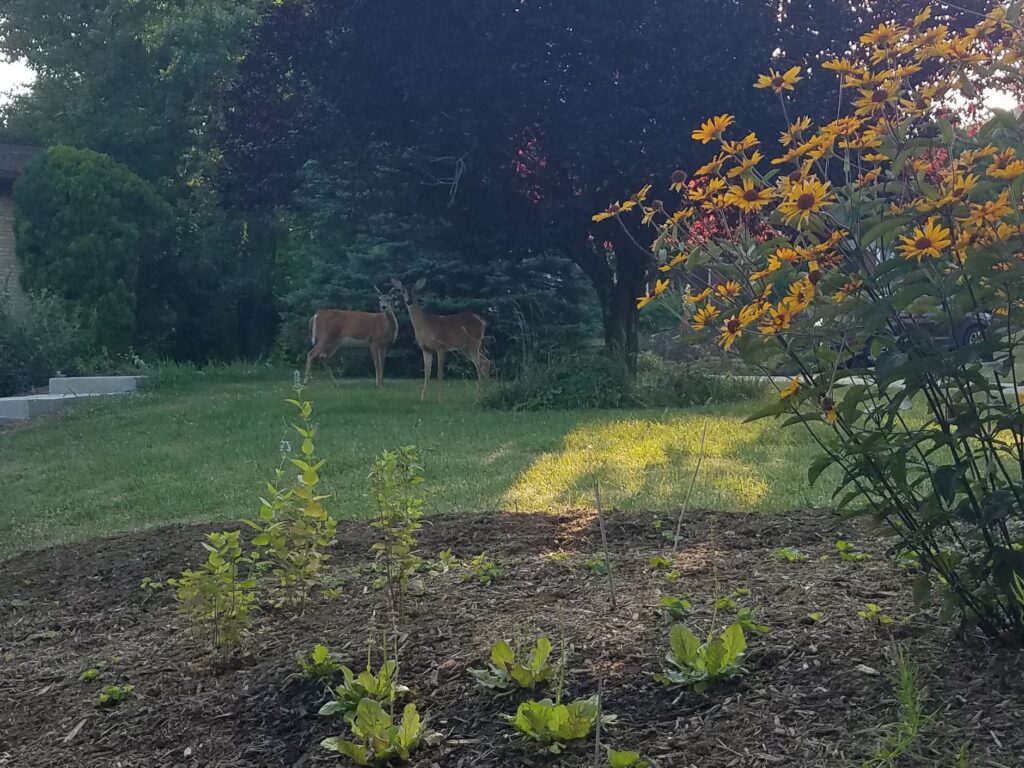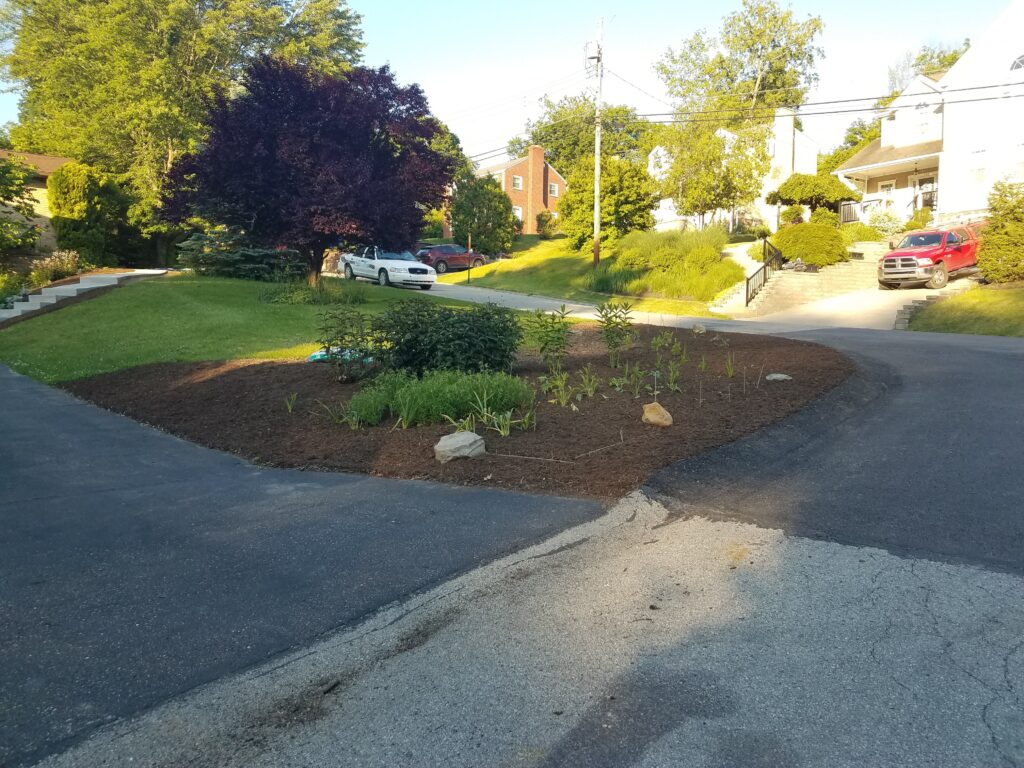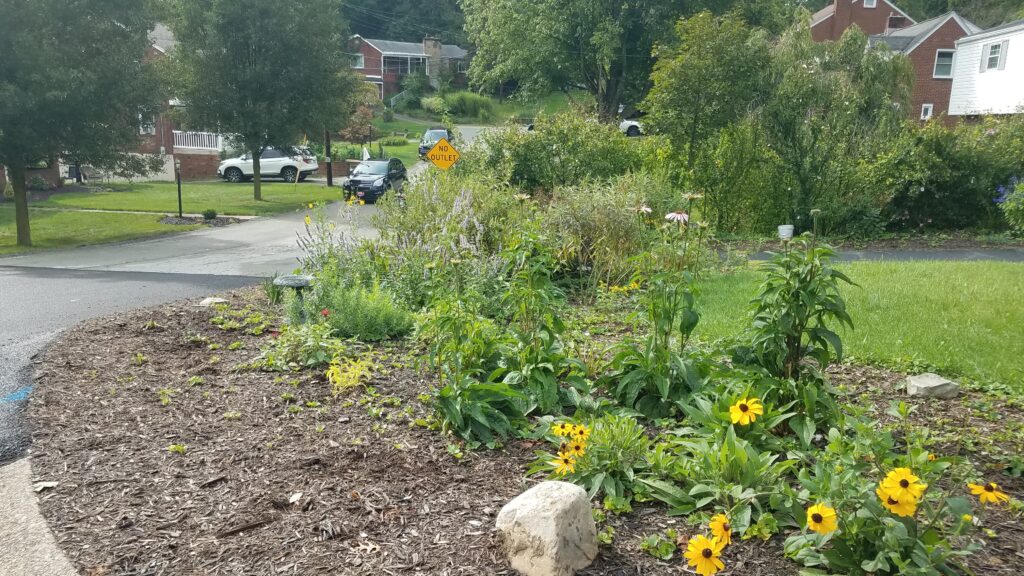Regular readers of this blog (or at least the gardening posts) may remember that I’ve been wrestling with an ambitious, expansive, pollinator-friendly garden project, which is now in its fifth year. Christian recently asked when I will be done with it (for good reason), and I explained that “capital-g Garden will never be done,” which is part of the beauty and also the frustration of such a project. To that end, this post provides another annual garden update for what turned out to be an incredibly productive year.
Begin with the End in Mind
I have difficulty envisioning what an artistic project will look like once it’s done, which is why if I start without a plan – or even something else to reference – the final result can look haphazard (and not in a wild way, which would be good in this instance, but in a forced way). That is why, after several years of hoping I would happen upon sufficient time and inspiration to create a plan myself, I finally gave up and turned to a professional landscape designer.

Now, I have one in the family who is a very talented artist and is my most trusted plant and pollinator expert. I would have loved for her to do the design – or even map out some ideas for me – but she runs her own business [1] and has even less time than I do. With that option gone, I looked elsewhere. Early this spring, I saw in my Facebook feed that a “local” nursery (about an hour south of me) that stocks plants native to western Pennsylvania [2] advertised a partnership with a landscape designer who creates plans using plants available at their shop.[3]
I completed a long survey about how we used the yard, what I wanted from the garden, styles and colors I liked, and how much time I would be able to put in every week for maintenance. The company used satellite photos of the yard to look at size, sun, and shade of the areas in question, and came back with a plan. And this plan, written with specific plants in mind that were largely available nearby, meant that I had the confidence to go purchase with abandon, which I did. In fact, I purchased no fewer than 135 new plants to go into the ground this year. (That does not count the annuals. I may have a problem.)
Anchor Plants
If the area in question is small enough, like a pot or a planter, I can assemble four or five complementary plants without much thought. However, my blank canvas was more than 1,000 square feet to start with (and continued to grow this year because I decided it wasn’t enough room for what I wanted to do). When I’m in the kitchen, I can’t cook without a recipe to reference – that’s not to say I don’t deviate from them, but I always need a place to start. Similarly with this garden plan, I followed some things to the letter, left other things out entirely, and improvised where I felt comfortable doing so.

The first thing I requested from the designer was some larger “anchor plants” to punctuate the landscape and provide some structure. I feel more comfortable working around unique items, such as shrubs, trees, or even a birdbath, which was the first thing I placed along my driveway two years ago.[4] The garden plan included several shrubs with which I was unfamiliar:
- Virginia sweetspire – Itea virginica [5]
- Swamp azalea – Rhododendron viscosum [6]
- a trio of New Jersey tea – Ceanothus americanus [7]
- Silky dogwood – Cornus amomum [8]
With the exception of New Jersey tea, these shrubs thrive and expand in moist soil and part-shade, which concerned me, as those were most definitely not the conditions they would be going into. I have since read that they would grow in the drier, sunnier spots where I put them, just not as prolifically. Either way, it will take several years to find out just how much they will dominate or disappear in the landscape, particularly since they are currently so much smaller than the plants surrounding them.

Although they are all native to the area, I had some trouble finding everything but the silky dogwood. For that reason, I had to order the other three by mail and mused at the irony of shipping New Jersey tea plants from Minnesota. The mail-order plants were, necessarily, small – and they became even smaller once our neighborhood deer did some investigating. Worried that they will shrink faster than they’re able to grow, I’m considering putting some chicken wire around them for the time being.
To the Letter
When starting out in a new venture of any kind (which I do quite often) I tend to follow guidelines exactly as given. It’s one of the reasons I prefer baking to cooking: it’s more of a science than an art. There is some comfort in following instructions precisely and expecting a certain outcome. In the garden, however, there are many more unpredictable variables than in the kitchen, which is a laboratory environment by comparison. And while there are absolutely important guidelines to remember for creating pollinator gardens (the science), there is most certainly a component of art involved to make the result visually pleasing for humans too.
One of the first things I read when I broke ground on the pollinator garden was that you should cluster plants of the same kind together. That makes it easier for foraging insects to gather pollen and nectar when it is available without having to search too hard for it. My response was to put all of the plants of a certain kind together in one large mass, with all plants of another kind in a large mass next to it, and so on. My approach largely consisted of looking for plants labeled “pollinator friendly” at the nursery near my house, buying them, and planting them next to whatever I had just planted.

Beginner’s luck made the combination of the first few plants (catmint, beardtongue penstemon, and yarrow) look beautiful together, but the progression after that became more haphazard and desperate in appearance as I ran out of ideas. Perhaps the most important lesson I learned from the garden plan this year was that while grouping plants is good, every single plant of that type doesn’t have to be placed together, especially in a very large garden space. Furthermore, groups of flowers don’t all have to be the same size – in area or in number. I now have a few larger swaths of one type of flower, surrounded by smaller clusters of other types of flowers, which helps create some visual variety in size, color, and blooming time.
With a little artistic assistance, my pollinator garden now has multiple clusters of the following sun-loving plants native to western Pennsylvania, all of which I was able to get from Arcadia Natives in Washington, PA as they became available throughout the growing season:
- Purple coneflower – Echinacea purpurea (planted in groups of 9 and 7) [9]
- Yellow coneflower – Ratibida pinnata (groups of 7 and 5) [10]
- Foxglove penstemon – Penstemon digitalis (7 and 3) [11]
- Black-eyed Susan – Rudbeckia hirta (5 and 3) [12]
Note: this one is a biennial, meaning it will flower every other year; some of them flowered this year, so I’m hoping some in each cluster will alternate - Cardinal flower – Lobelia cardinalis (4 groups of 3) [13]
- New England aster – Symphyotrichum novae-angliae (3 groups of 3) [14]
(Not in in the ground quite yet – I still have the very last of my summer planting to do as of this post) - Scarlet bee balm – Monarda didyma (3 groups of 3) [15]
- Virginia mountain mint – Pycnanthemum virginianum (3 groups of 3) [16]
- Anise hyssop – Agastache foeniculum (3 and 3) [17]

There are plenty more factors to consider when starting a pollinator garden, such as ensuring sufficient water, food, and shelter for the visitors you want to support,[18] but those topics could fill another post on their own. I personally am thrilled to have a range of native plants that are hard to find at big box garden centers and even some family-owned nurseries. But the plant in my garden about which I am most excited right now – one of the reasons I started down this path to begin with – is one we’ll talk more about next week: milkweed.
~
What are your favorite native plants in your garden? How hard were they to find? I’d love to hear about your own gardening adventures below.
Thanks for reading!
[1] http://pharogardencentre.com/
[2] https://arcadianatives.com/
[3] https://www.earthlovegardens.com/
[4] https://radicalmoderate.online/pollinator-garden-update-2021/
[5] https://www.wildflower.org/plants/result.php?id_plant=ITVI
[6] https://www.wildflower.org/plants/result.php?id_plant=rhvi2
[7] https://www.wildflower.org/plants/result.php?id_plant=CEAM
[8] https://www.wildflower.org/plants/result.php?id_plant=COAM2
[9] https://www.wildflower.org/plants/result.php?id_plant=ECPU
[10] https://www.wildflower.org/plants/result.php?id_plant=RAPI
[11] https://www.wildflower.org/plants/result.php?id_plant=PEDI
[12] https://www.wildflower.org/plants/result.php?id_plant=RUHI2
[13] https://www.wildflower.org/plants/result.php?id_plant=LOCA2
[14] https://www.wildflower.org/plants/result.php?id_plant=SYNO2
[15] https://www.wildflower.org/plants/result.php?id_plant=MODI
[16] https://www.wildflower.org/plants/result.php?id_plant=PYVI
[17] https://www.wildflower.org/plants/result.php?id_plant=AGFO
[18] https://www.gardenista.com/posts/native-pollinator-garden-crash-course/
0 Comments